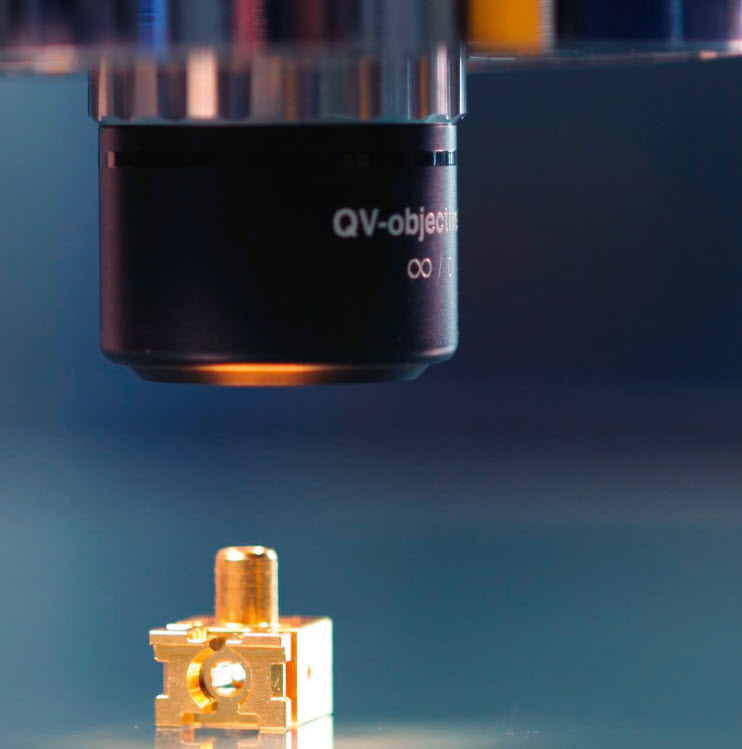Where to put the "qualifiers"?
Quality assurance has focused on the inspection of workpieces and products for decades. This has lifted it into a world of its own, far removed from direct manufacturing activity. Now, stability is being put to the test. New challenges and advances in production measurement technology are setting a new course.

When in 1965 the SAQ was founded, it was called the "Swiss Working Group for Quality Promotion". The founding fathers were Swiss production companies such as, among others Alusuisse, Brown-Boveri, Bührle, Contraves and Landis & Gyr. It was the time when the post-war economy, which focused mainly on the quantity of production, began to crumble and the export industry came to the realization that long-term success on world markets can only be achieved through the quality and reliability of their products.
In October 1976, Vaduz saw the launch of the first SAQ Group the Rhine Valley Section (now the Eastern Switzerland Section) from the baptism, among others by groups such as Hilti, Leica Geosystems and Elesta. Their machines, plants and systems should function absolutely reliably. If they do not, this can lead to serious consequences or, in the case of recalls, to considerable costs, not to mention the loss of image for the companies concerned.
Stable tradition
For decades, the concept of quality was primarily defined as quality assurance. Quality assurance encompasses the totality of properties and characteristics of a product to fulfill defined functions and requirements. "Zero defects" becomes the guiding principle. Quality assurance and quality control become almost synonymous terms. Metrology plays a key role in this.
Swiss companies make use of the expertise of universities and research institutions in the development of metrological methods and technologies as well as in engineering training. Particularly worthy of mention are the Institute for Production Metrology, Materials and Optics (PWO) at the NTB Interstate University of Applied Sciences in Buchs, the Institute for Machine Tools and Manufacturing at ETH Zurich, the EMPA and the CSEM in Neuchâtel. These cooperate as partners in training and research, a concentrated competence of quality assurance and metrology from which the companies can benefit in maintaining competitiveness.
Fatal self-image
Measurement and testing, and later defect and requirements management, develop into specialist areas with a relatively high degree of independence and constant responsibilities. "Quality specialists" are to measure products in the sense of checking results. Quality is only ensured if tolerances and other parameters are adhered to. According to their self-image, quality assurance must therefore be independent of production, even "neutral" - an attitude with basically fatal consequences.
Production companies are primarily oriented to unit numbers and productivity. There is a danger that production targets are given higher priority than quality targets in daily practice. The result: Quality assurance, entrusted with measuring, testing, sampling and auditing tasks, finds itself pushed into a special role, away from the actual value creation, which often results in conflicting goals and ambiguity as to who is responsible for what.
In their own world
In contrast to production, quality activities take place much less in consecutive processes. Large parts of quality assurance exhibit characteristics of a complex system, networked with numerous influencing and design variables. Measurement technology in the laboratory or measuring room is an expression of this development. Here, workpieces are precisely examined with regard to their geometry, shape and bearing tolerances, and surface properties. A large number of high-precision devices, ranging from three-dimensional coordinate, form and surface measuring machines, are in use. With very high accuracy requirements, they can only deliver the required results under constant ambient conditions. The measuring room practically stands for the special position of quality assurance outside of production.
Lack of integration and the strict division of responsibility, according to which production is exclusively responsible for achieving quantities and quality assurance for quality, can lead to "qualifiers" and "finishers" drifting apart. There is a danger that production will "push off" all quality issues to quality assurance, and that quality assurance itself will detect defects but not contribute significantly to eliminating them. How can this development be redirected?
"When no one has time anymore, measurement should be done", Prof. Dr.-Ing. Claus P. Keferstein
Breakthrough to new identity
"We measurement engineers are all poor guys," complained Prof. Dr.-Ing. Claus P. Keferstein, then head of the PWO Institute, at a symposium in Buchs in 2011. Typical of the practice in companies, he said, is that trade fairs are only in demand when the product is already finished. "When no one has time anymore, measurement should be done," Keferstein said, concluding, "Measurement technology must become productive." Early measurement brings more value, benefits and economic advantages, he said.
A paradigm shift is taking place in production metrology: Quality cannot be tested in, it has to be produced, is the credo. The starting point is at the point of origin. This means that, as far as possible, quality activities should be carried out close to production or directly in the manufacturing process.
Prof. Keferstein is convinced: "Productive metrology' radically does away with previous processes that merely sort out defective products. Defects must already be prevented during production through improved processes. The decisive factors for measuring in production will be the measuring speed, the robustness of the measurements and the fully automatic detection of tolerance violations without causing collisions and other damage."
Challenges of the future
Quality assurance can no longer detach itself from global trends and take refuge in the tranquility of its long-standing stability: Growing complexity and diversity of product variants, resource efficiency, mastery of new production technologies, flexibilization and transparency are gaining in importance. And as the demands on quality continue to rise, metrology is becoming an increasingly important tool in ensuring it.
The advance of miniaturization, the increase in product service life and increased efficiency of entire assemblies mean that ever tighter tolerances are required for individual workpieces. Whether for mechanical, optical or electronic components: Measurement and testing are becoming increasingly complex as the parts become smaller, the tolerances become tighter, and quality defects have more consequences for the success of the company.
Technical innovations
Parallel to these challenges, the methods and tools of production metrology itself have changed dramatically. Innovations in coordinate and surface metrology (keyword: multi-sensor coordinate metrology), in optical processes, in non-contact measuring and testing technology, but also the IT-supported mechanization of QA methods through software support such as CAQ (computer aided quality management) and SPC (statistical process control) should be mentioned here. Quality requirements have long since exceeded classic procedures, but also the traditional role model of quality inspectors.
The trend to bring measurement technology ever closer to production has increased enormously in recent years. The classic measuring room far away from the direct process is likely to play only a subordinate role in the future and be limited to special or specialized tasks. Measurement technology in the manufacturing process and measurement close to the process set the pace. For example, "worker self-inspection" is becoming increasingly important in modern factories. Using optical measuring machines, skilled workers on site at the machines can independently check dimensional, form and positional tolerances on parts in random samples during production and evaluate them statistically. Or, thanks to optical sensor systems, measurements can be taken automatically directly in the machine tools. The automation of visual inspection with image processing is further accelerating this development.
New role
Embedding in the manufacturing organization will significantly change quality assurance. The automation of measurement and testing technology and of defect handling is advancing, as is the networking of data and information on processes, causes of defects and process control. Quality assurance can thus grow into a new role as moderator and coordinator between production and development and distinguish itself as a solution-oriented service provider for the entire value creation process. In this way, the competencies of the "quality experts", usually highly qualified engineers with a great deal of experience, can finally be adequately utilized in the companies. The path is moving from individual testing to the management of quality.
The SAQ changed its name to "Swiss Association for Quality" in 2001. With this expansion, the association moved out of the narrow track of traditional quality assurance and opened up to modern quality management up to business excellence. The further integration of quality assurance into modern management systems still remains an open question.
Book tip https://bit.ly/25LBs1W









